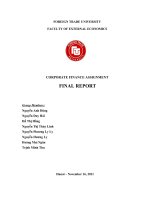final report electronics circuit design 1
Bạn đang xem bản rút gọn của tài liệu. Xem và tải ngay bản đầy đủ của tài liệu tại đây (5.95 MB, 26 trang )
<span class="text_page_counter">Trang 1</span><div class="page_container" data-page="1">
<b>TRƯỜNG ĐẠI HỌC TÔN ĐỨC THẮNG KHOA ĐIỆN – ĐIỆN TỬ </b>
FINAL REPORT
ELECTRONICS CIRCUIT DESIGN 1
Lecture: ThS.TR N THÀNH NAM Ầ Students:
<i>Cao Đặng Tiến Phú - 420H0170 </i>
Nguy n Ng c Huân - 420h0190 <i>ễọ</i>
Phan Thanh Liêm - 420H0132
HO CHI MINH CITY, YEAR 202
</div><span class="text_page_counter">Trang 2</span><div class="page_container" data-page="2">Table ole ole of Cf Contf Contontentsentsents
ADAPTER 2 D<small>ESIGN STEP DIAGRAM</small> ... 2
1.1.1 Transformer... 2
1.1.2 Diode Rectifier & Filter ... 3
1.1.3 Voltage regulation & Load ... 3
</div><span class="text_page_counter">Trang 3</span><div class="page_container" data-page="3">𝑁<sub>2</sub><sup>=</sup><sup>𝑉</sup>𝑉<sup>1</sup><sub>2</sub><sup>=</sup><sup>𝑉𝐴𝐶</sup>𝑣<sub>𝑆</sub> <sup>=</sup><sup>220</sup>22= 10
220Vrms 50Hz
</div><span class="text_page_counter">Trang 4</span><div class="page_container" data-page="4">1.1.2 Diode Rectifier & Filter
We use the Full-Bridge Rectifier to minimize the loss. Base on the figure above, we have the formulation:
𝑣<small>𝑆</small>= 2 × 𝑉<small>𝐷𝑖𝑜𝑑𝑒</small>+ 𝑣<small>𝑜𝑢𝑡−𝑟𝑒𝑐𝑡𝑖𝑓𝑖𝑒𝑟</small>
⟹ 𝑣<small>𝑜𝑢𝑡−𝑟𝑒𝑐𝑡𝑖𝑓𝑖𝑒𝑟</small>= 𝑣<small>𝑆</small>− 2 × 𝑉<small>𝐷𝑖𝑜𝑑𝑒</small>= 22√2 − 2 × 0.7 = . (𝑉) 29 71
Choose 𝐶 =100𝑚𝐹⟹ 𝑍<small>𝐶</small>=<sub>𝜔𝐶</sub><sup>1</sup>= <sub>2𝜋𝑓.𝐶</sub><sup>1</sup> = <sub>2𝜋. .</sub><sub>50 100 10</sub><sup>1</sup> <sub>×</sub> <sub>−3</sub>= 0.03 Ω (𝑣𝑒𝑟𝑦 𝑠𝑚𝑎𝑙𝑙) So 𝑣<sub>𝑜𝑢𝑡−𝑓𝑖𝑙𝑡𝑒𝑟</sub>≈ 29 71 𝑉 .
</div><span class="text_page_counter">Trang 5</span><div class="page_container" data-page="5">Base on the figure above, we also have: 𝐼<small>𝑙𝑖𝑚𝑖𝑡</small>= 𝐼<small>𝑧</small>𝑚𝑎𝑥 + 𝐼<small>𝑜</small>
⟺<sup>𝑣</sup><sup>𝑜𝑢𝑡−𝑓𝑖𝑙𝑡𝑒𝑟</sup><sub>𝑅</sub> <sup>− 𝑉</sup><sup>𝑧</sup>
<small>𝑙𝑖𝑚𝑖𝑡</small> = 𝐼<small>𝑧</small>𝑚𝑎𝑥 + 𝐼<small>𝑜</small>
⟺<sup>29.71 − 10</sup><sub>𝑅</sub>
<small>𝑙𝑖𝑚𝑖𝑡</small> = 40 10× <small>−3</small>+ 1.2 ⟹ 𝑅<small>𝑙𝑖𝑚𝑖𝑡</small>= 15 89. Ω
</div><span class="text_page_counter">Trang 6</span><div class="page_container" data-page="6">Simulation 1.2.1 Transformer
</div><span class="text_page_counter">Trang 7</span><div class="page_container" data-page="7">Results:
</div><span class="text_page_counter">Trang 9</span><div class="page_container" data-page="9">1.2.2 Diode Rectifier
1.2.3 Filter
Add a Capacitor to reduce wave amplitude
</div><span class="text_page_counter">Trang 10</span><div class="page_container" data-page="10">Results:
</div><span class="text_page_counter">Trang 11</span><div class="page_container" data-page="11">1.2.4 Voltage Regulater & Load
To set the output steady, we must use the diode Zener with 𝑉<small>𝑧</small>= 10𝑉 to meet the requirement of the threads.
</div><span class="text_page_counter">Trang 12</span><div class="page_container" data-page="12">Results:
</div><span class="text_page_counter">Trang 16</span><div class="page_container" data-page="16">OpAmp Circuit
Thiết k m ch khuế ạ ếch đạ ử ụi s d ng OPAMP sao cho 𝒗<small>𝒐</small> = 𝟓𝒗 + 𝟏𝒗 + 𝟑𝒗 −<small>𝟏𝟐𝟑</small>
𝟐𝒗<small>𝟒</small>. V v n u bi ẽ <small>o</small> ế ết:𝑣<sub>1</sub> = 1 𝑠𝑖𝑛 (1000𝜋𝑡) 𝑣<sub>2</sub> = 2 𝑠𝑖𝑛 (2000𝜋𝑡) 𝑣<small>3</small> = 3𝑠𝑖𝑛 (3000𝜋𝑡) 𝑣<small>4</small> = 4 𝑠𝑖𝑛 (4000𝜋𝑡)
The Complete Circuit
Calculation
</div><span class="text_page_counter">Trang 17</span><div class="page_container" data-page="17">𝑣<sub>4</sub> = 4 𝑠𝑖𝑛 (4000𝜋𝑡) ⟹ 𝑣<sub>4</sub>= 2(𝑉); 𝑓<small>4</small>=<sup>4000𝜋</sup><sub>2𝜋 = 2000 𝐻𝑧</sub>
<b>Parameters: </b>
R1=16kΩ R2=80kΩ R3=80/3kΩ R4=30kΩ R5=60KΩ Rf1=80kΩ Rf2=60KΩ
𝑣𝑜 = 5𝑣 + 1𝑣 + 3𝑣<small>123</small>− 2𝑣<small>4</small>Select gain: 𝑅𝑓2
𝑅5
= 1
𝑅5∗<sup>𝑅𝑓1</sup>𝑅1= 5𝑅𝑓2
𝑅5∗<sup>𝑅𝑓1</sup>𝑅2= 1𝑅𝑓2
𝑅5∗<sup>𝑅𝑓1</sup>𝑅3= 3𝑅𝑓2𝑅4= 2
</div><span class="text_page_counter">Trang 18</span><div class="page_container" data-page="18">Choose Rf2 = R5 = 60KΩ𝑅𝑓2
𝑅4= 2 → 𝑅4 = 30𝑘<sup>Ω </sup>Choose Rf1 = 80kΩ 𝑅𝑓1
𝑅1= 5 → 𝑅1 = 16𝑘<sup>Ω </sup>𝑅𝑓1
𝑅2= 1 → 𝑅2 = 80𝑘<sup>Ω </sup>𝑅𝑓1
𝑅3= 3 → 𝑅3 = /3𝑘<sup>80</sup> <sup>Ω </sup>
Simulation 1.6.1 Input data
</div><span class="text_page_counter">Trang 21</span><div class="page_container" data-page="21">1.6.2 Elements data
</div><span class="text_page_counter">Trang 24</span><div class="page_container" data-page="24">1.6.3 The simulation result
The simulation results of the following 𝑣<sub>1</sub>; 𝑣 ; 𝑣 ; 𝑣<sub>2 3</sub> <sub>4</sub>
</div><span class="text_page_counter">Trang 26</span><div class="page_container" data-page="26">The simulation result of 𝑣<small>𝑜</small>
</div>








